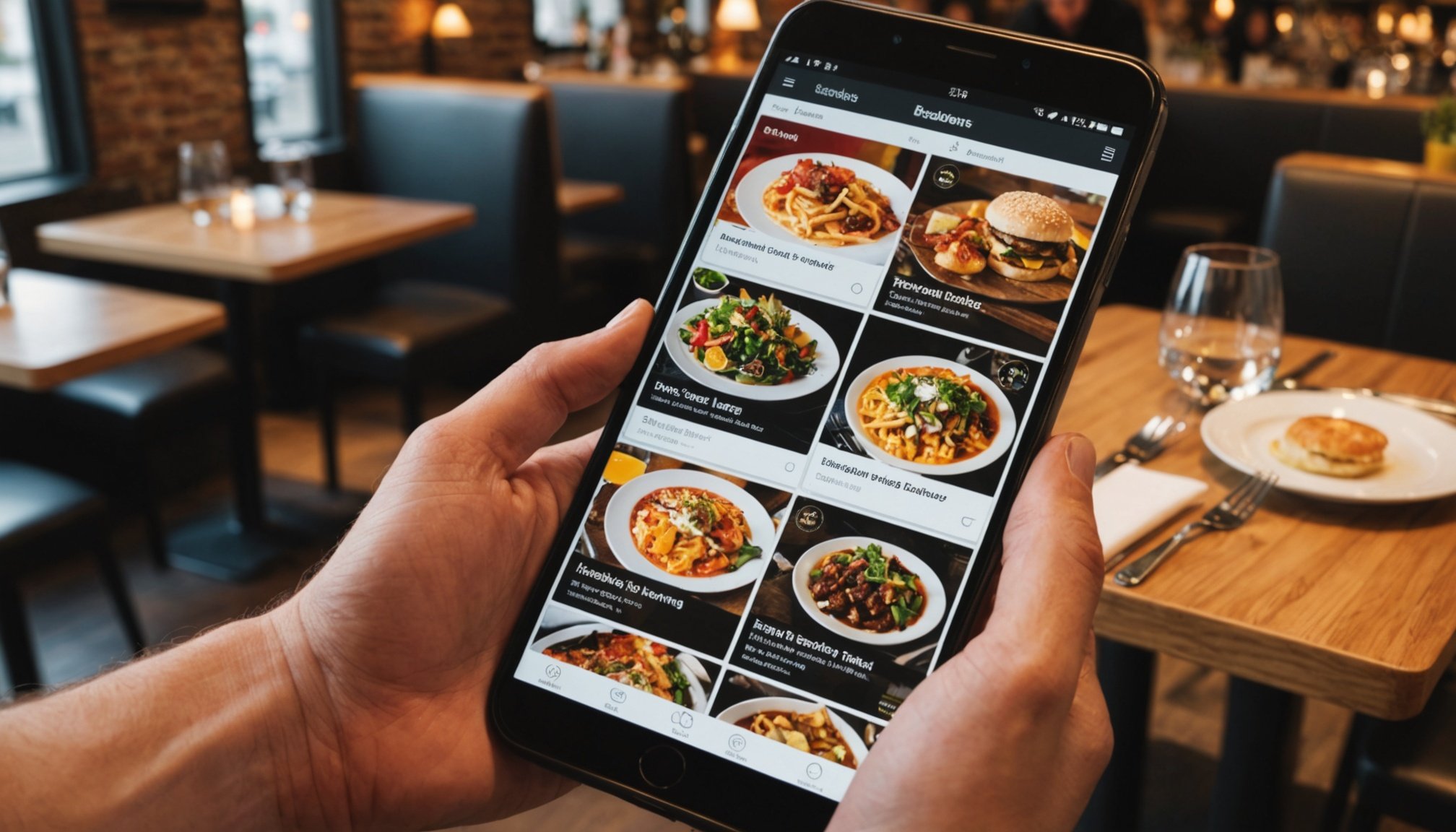Overview of Digital Menus in UK Restaurants
In recent years, UK restaurants have embraced a significant dining transformation through the adoption of digital menus. Initially, digital menus began as an experimental approach to enhance customer experience. Now they are transforming the hospitality industry across the region. But what exactly are digital menus? Essentially, they are electronic systems that replace traditional paper versions. This method leverages technology to offer an interactive and often customizable way for patrons to view menu items.
The evolution of digital menus has been largely driven by technological advancements and shifts towards convenience. Touchscreens, QR codes, and mobile applications have become popular means of accessing these menus, providing unparalleled convenience for diners. The adoption rate in UK restaurants is impressive, with many establishments opting for this innovative method. According to industry reports, a majority of mid-to-high-end restaurants have already transitioned to digital menus, motivated by the enhanced customer engagement and reduced overhead costs associated with this tool.
Key reasons for this transition include the ability to update menu content in real-time, improving operational efficiency and offering eco-friendly solutions. In a world where experiences are increasingly digital, this transformation aligns well with consumer habits and expectations, making dining out not only enjoyable but also efficient.
Features of Digital Menus
Digital menus are revolutionising the dining experience by integrating interactive experiences and boosting customer engagement. One of the standout features is the ability for diners to customise and personalise their meals. This means customers can easily adjust their orders based on dietary preferences or allergens, ensuring a more tailored dining experience. Imagine having the power to substitute ingredients or adjust portion sizes directly from your table!
Additional reading : Strategies for uk companies to enhance customer service and boost client loyalty
Moreover, the integration of multimedia elements such as images and videos serves to elevate the menu appeal significantly. Visuals of dishes can entice diners, while videos detailing the preparation process or chef’s recommendations can enhance their understanding and excitement about their meal choices. This multimedia incorporation transforms the traditional menu into a dynamic and engaging tool.
Another significant benefit of digital menus is their capability for real-time updates. Restaurants can promptly update menu items and pricing, reflecting ingredient availability or changes in costs. Diners thus receive the most current information, minimising disappointment from unavailable items.
By offering these features, digital menus not only enhance operational efficiency for restaurants but also enrich the dining experience for customers, making meals more enjoyable and interactive. Thus, these menus are reshaping how diners interact with and perceive food choices.
Case Studies of Digital Menu Implementation
Transforming menus through digital means has reshaped how restaurants operate in the UK. The impact is noticeable across various dining styles, showcasing diverse implementations.
A Fine Dining Experience
In the fine dining landscape, digital menus have introduced elegance and efficiency. Through seamless integration with the restaurant’s branding, these menus enhance the aesthetic appeal and streamline the ordering process. Customers appreciate the precision and clarity digital menus provide, offering detailed information about ingredients and wine pairings. A particular case study from a renowned London establishment revealed increased customer satisfaction and a notable reduction in order errors.
Casual Dining Approach
For casual dining, digital transformation has brought a balance between technology and comfort. Restaurants have embraced digital menus with interactive features, allowing patrons to customise their orders effortlessly. Feedback indicates an improvement in customer engagement and waiting times. A study involving a popular UK chain highlighted how tablet-based menus increased order accuracy and table turnover rates.
Fast Food Innovations
Fast food restaurants have leveraged digital menus to speed up service and integrate loyalty programs. Implementations have shown improvements in operational efficiency and customer retention. An overview of a major fast-food outlet’s digital shift saw a 20% boost in customer satisfaction due to faster service and personalised offers, reinforcing the appeal of this innovative approach.
Advantages for Customers
In the dynamic realm of dining, customer benefits are paramount. Enhanced convenience is a key advantage, boosting customer satisfaction through seamless navigation and accelerated ordering processes. This convenience allows diners to focus on enjoying their meal rather than being weighed down by the logistics of ordering and waiting.
Such innovations not only improve the dining experience but also forge a path toward customer loyalty. When customers are able to swiftly order their chosen dishes while enjoying intuitive interface systems, they are more likely to return and recommend the venue. A rewarding experience often leads customers to favour a particular restaurant over its competitors.
Moreover, accessibility features play a pivotal role in accommodating a spectrum of diverse customer needs. Restaurants can ensure a welcoming atmosphere by incorporating features tailored for those with disabilities, ensuring that everyone can partake in an inclusive dining experience. This results in a more satisfied customer base, appreciative of the value placed on universal access.
These advantages collectively contribute to a sustainable and engaging dining environment, with customer satisfaction taking centre stage. The emphasis on innovation and inclusivity helps restaurants retain a loyal clientele, fostering long-term growth and success in an increasingly competitive market.
Benefits for Businesses
Incorporating modern technologies into your business operations can lead to substantial advantages. Notably, it offers cost-saving opportunities through reduced printing and updating expenses. Traditional marketing materials and menus often require constant revision and reprinting, which can be costly. By leveraging digital solutions, businesses can make instant updates without incurring additional printing costs, thereby enhancing overall efficiency.
Moreover, an increase in table turnover and more efficient service contributes significantly to business advantages. Quick access to information and digital menus allows customers to make faster decisions, which leads to quicker table turnover. This not only maximizes the utilization of seating areas but also enhances customer satisfaction by reducing wait times.
Beyond operational efficiencies, better data collection plays a pivotal role in boosting profitability. Businesses can gather valuable insights into customer preferences and behavior, enabling personalized marketing strategies. This targeted approach caters directly to customer interests, increasing engagement and loyalty, ultimately leading to higher sales and profitability.
To sum up, integrating these advancements provides multiple benefits:
- Cost savings through reduced printing needs
- Improved efficiency, resulting in greater customer satisfaction
- Enhanced data collection for strategic decision-making
Adopting these solutions can position businesses strategically in today’s competitive market.
User Testimonials and Feedback
Understanding how digital menus transform the dining experience is pivotal for their success. Customer testimonials offer insights into this transformation, blending user perspectives into a coherent narrative. Real-life experiences often highlight increased satisfaction post-adoption of digital menus. Patrons appreciate the convenience of browsing menus at their leisure, reducing pressure during busy periods.
User insights reveal notable trends; customers report faster service and more personalized dining. Prior to digital menus, long waits and miscommunication were common grievances. Now, diners enjoy streamlined interactions with waitstaff and intuitive ordering processes. As one diner noted, “It’s like having a personal menu that waits for me—not the other way around.”
Feedback consistently emphasizes improvements in overall dining experiences. Customers frequently cite the visual appeal of digital displays, which enhance menu clarity and accessibility. Additionally, users value real-time updates, ensuring access to the latest specials and seasonal offerings. A customer described how “the chef’s recommendations are now a click away, making my choice so much easier.”
Overall, these testimonials reflect a trend towards greater satisfaction. The move to digital menus is seen as a positive leap in enhancing customer service efficiency and enjoyment, ultimately creating a more welcoming environment. This feedback is essential for restaurants aiming to optimize their digital menu offerings to better cater to their patrons.
Statistical Data on Customer Satisfaction
Exploring customer satisfaction statistics in the realm of digital dining reveals vital insights into modern preferences. A variety of surveys and studies underline how digital transformations impact dining experiences. According to a recent survey, approximately 70% of diners reported an enhanced satisfaction level when using digital menus compared to traditional ones. This shift reflects a growing demand for convenience and efficiency among consumers.
Examining survey results, it’s evident that digital dining facilitates faster service, with 65% of customers indicating they appreciate the reduced wait times. This aspect significantly contributes to overall satisfaction, highlighting a major benefit of digital dining systems. Furthermore, digital menus often offer detailed descriptions and nutritional information, proving advantageous for 60% of health-conscious diners.
In terms of statistical analysis, there’s a notable relationship between digital menus and increased satisfaction levels. Digital interfaces not only streamline ordering processes but also reduce errors, thus improving accuracy—a factor reported to increase satisfaction rates by up to 15%.
When comparing traditional to digital dining experiences, digital services have shown a consistent edge in customer contentment. Customers highlight the ease of customization and payment options as superior in digital formats, contributing to a holistic and satisfying dining experience. This data-driven evidence underscores the transformative power of digital solutions in enhancing customer experiences.
Challenges in Adopting Digital Menus
As restaurants venture into the realm of digital dining, various challenges and barriers can impede the seamless adoption of digital menus. Common hurdles often lie in the implementation phase, where restaurants must integrate new technologies into existing operations without disrupting the dining experience.
One of the primary barriers is customer resistance. Patrons may feel overwhelmed by digital interfaces, especially those less adept with technology. This hesitancy can contribute to a digital divide, particularly impacting older customers who might prefer traditional paper menus. To address these concerns, restaurants can provide user-friendly interfaces and support from tech-savvy staff to assist less confident diners.
Another challenge involves technology reliability. Glitches or downtime can lead to frustration among both customers and staff, potentially impacting the restaurant’s reputation. Consistent system maintenance and robust IT support are crucial to prevent technological failures. Furthermore, staff training is essential to ensure smooth operation. Employees need to be well-versed in using and troubleshooting the digital systems to maintain service quality and customer satisfaction.
In summary, the journey to fully embracing digital dining involves overcoming various challenges, from technological integration and customer acceptance to ensuring reliability and effective staff training. Addressing these barriers can lead to a successful transition towards a more innovative dining experience.
Future Trends in Digital Dining Experiences
Digital dining experiences are evolving rapidly with the increasing influence of emerging technologies. Restaurants are embracing innovation to enhance customer interactions and streamline operations. One trend shaping the future of digital menus is the integration of AI and machine learning, enabling customised menu recommendations based on previous orders, dietary preferences, and nutritional information. This personalisation enhances customer satisfaction and increases the likelihood of repeat visits.
Predictions indicate a significant shift in customer preferences towards convenience and efficiency, driven by technological advancements. Contactless payments and QR code-based digital menus have already become common, reducing wait times and minimising physical contact — factors particularly important in a post-pandemic world. As customer preferences lean towards these innovations, restaurants must adapt to meet evolving demands.
The potential shifts in the restaurant industry’s landscape due to digital adoption are numerous. Automation technologies, such as robotic chefs and service bots, might redefine dining experiences, allowing staff to focus more on creative tasks and customer relations. Additionally, virtual and augmented reality could transform traditional dining, providing an immersive experience that goes beyond food. Embracing these future trends, restaurants can remain competitive and deliver exceptional dining experiences to tech-savvy customers.






